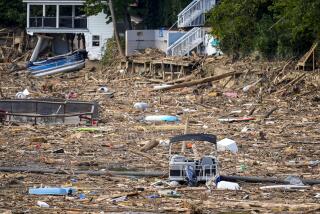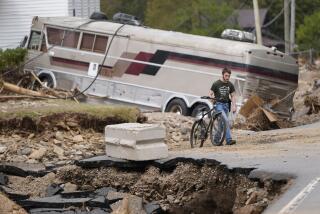9 Killed as Isabel Wallops the East
- Share via
VIRGINIA BEACH, Va. — Howling like a crippled beast, Hurricane Isabel crawled across the Outer Banks of North Carolina and into Virginia on Thursday, weakening but still wild enough to snap aluminum power poles, flip house trailers and black out more than 2.6 million homes and businesses.
Nine people died. Seven were killed in traffic accidents, one was crushed by a falling tree, and one was a utility employee electrocuted while trying to restore power.
The government shut down in Washington, and federal offices are to remain closed today. Airlines canceled more than 2,000 flights Thursday to and from the East Coast, and Amtrak halted trains south of the District of Columbia. Schools closed in North Carolina, Virginia, Maryland, Delaware and the nation’s capital.
President Bush declared a disaster in North Carolina and Virginia, ordering federal aid for repairs and low-cost loans to cover uninsured property losses.
At 2 a.m. EDT today, the eye of the storm was centered just north of Charlottesville, Va., according to the National Hurricane Center in Miami. Isabel had been downgraded to a tropical storm and was moving northwest at 23 mph. Maximum sustained winds had dropped to about 60 mph and extended 345 miles from its center.
A tropical storm warning extended northward to Long Island and included parts of New York City. Forecasters said Isabel would continue to weaken, but they predicted heavy flooding and landslides as far north as West Virginia, Pennsylvania and New York.
The storm threatened to spawn tornadoes as it hurtled north.
While the hurricane was still far to the south, officials in Washington closed federal offices, except for emergency operations. Universities and private businesses followed suit.
The president and many members of Congress had left town the day before, while skies were clear. Bush flew by helicopter to his retreat at Camp David in Maryland. The king and queen of Jordan went to the retreat Thursday, met with Bush and spent the day.
In the District of Columbia, workers began distributing sandbags. By midday, at least 8,000 had been filled with more than 100 tons of sand in preparation for flooding. Subways and buses stopped running, and officials said they would decide after an inspection at 5 a.m. today whether to restore transit service.
All along the southeastern coast, people took shelter Thursday and braved Isabel as best they could.
“What I could use is a change of scenery,” said Craig Tulley, taking shelter inside a Shell station in Virginia Beach. He was soaking wet. The wind flung doors open behind him and howled inside until clerk Will Batts pulled them shut again.
On the Outer Banks, Tom Gardner and his wife, Susan, rode out the storm in their six-room bed-and-breakfast, the Tree Seasons Guest House, in Kitty Hawk, N.C., only 36 feet above sea level.
“We have no power and no cable,” Tom Gardner said by telephone at 1 p.m. as Isabel made landfall near Drum Inlet, about 100 miles to the south between Cape Lookout, N.C., and Ocracoke Island. “The waves are vicious.”
The landfall came at high tide, and the hurricane swamped Highway 12, a crucial route running through the Outer Banks. Public safety officials said the road was impassable.
Twenty-five-foot waves cascaded against the Virginia Beach shoreline, and the city pier and boardwalk began to crumble. In the nearby community of Sandbridge, ocean water leached into backyards, rushed over bridges and eroded sea sand.
At least 1,800 Virginia Beach residents fled its coastline neighborhoods and took refuge in eight shelters, said city spokeswoman Diane C. Roche. But the shelters had their own problems. One elementary school lost power, and a high school grew so crowded that officials turned scores of people away.
Virginia Gov. Mark R. Warner said at least 4,000 residents filed into 85 shelters around the state, and at least 5,000 National Guardsmen went on duty to protect their property.
Isabel was born a nasty storm that grew into a Category 5 hurricane -- the strongest there is -- as it moved toward the East Coast. Forecasters said it reached winds of 160 mph on Sunday.
Five days ago, officials began urging more than 300,000 people in North Carolina and Virginia to flee to higher ground. Anyone who stayed, they said, should notify next of kin and write their names on their forearms with permanent markers so they could be readily identified.
But by the time Isabel struck land, some of its strength was gone. Indeed, about 100 of the 900 residents of Ocracoke Island reportedly chose to stay home.
They and many others lost power. About 2 million customers were blacked out during the afternoon in southeastern Virginia and eastern North Carolina alone, according to Associated Press, along with 430,000 in Maryland, 78,000 in the District of Columbia and 100,000 in New Jersey.
Storm surges swelled to 6 feet at Cape Hatteras, N.C., and about 4 feet in the Neuse River at New Bern, N.C.
Richard and Lu Hoff of New Bern hunkered down in their 200-year-old home, built by a Colonial governor. “We’ve been through four to six hurricanes,” said their son, Richard.
Before the height of the storm, Lee Black drove into New Bern from nearby James City and went to the Sheraton Hotel. He sat in the bar and played a “Monster Mash” video game while the wind roared.
“I’m going to hang out and have a cold beer,” he said, “and sit here and watch the storm ride through.”
On Albermarle Sound in Chowan County, N.C., growing blasts of wind felled trees and power lines, and the Sheriff’s Department switched on backup generators about 11 a.m.
“It’s raining hard here, and the wind gusts are up to 35 to 40 [mph],” Sheriff Fred A. Spruill said by telephone at midday. “We’re sitting right on the water, so we expect flooding. We’ve moved as many of our people into shelters as we can.”
On Harkers Island, N.C., retired commercial fisherman Otis Nelson said the midday weather was “terrible -- blowing hard.”
“Nobody’s going out [fishing] today,” he said.
On the northern Outer Banks, high surf breached sand dunes and broke against the walls of more than 30 upscale homes, said Julie Cherry, emergency medical services captain for the Corolla, N.C., Fire Department.
Each home was worth more than half a million dollars, she said. “They’re really oceanfront properties now.”
The storm even disrupted emergency services. “I can’t even send an ambulance out because it would get blown over,” Cherry said. Dispatching fire trucks also was pointless, she said, because the wind would strip away folded hoses and send them sailing away.
One road on the Outer Banks north of Duck, N.C., was awash with seawater, Cherry said, and other roads were littered with shingles and vinyl siding. She said another was blocked by a roof.
Oceanfront gazebos and walkways leading over dunes to the ocean were destroyed.
In Bayboro, N.C., Candace Young, proprietor of Bay River Pottery, held a hurricane party that was well under way when Isabel’s eye blew overhead about an hour after landfall.
“It was very calm and quiet” in the eye of the storm, Young said.
She said she served Brie, French bread, grapes, crackers, dip and peanut butter and jelly sandwiches -- but no alcoholic beverages “because you have to have a clear head.”
Outside, she said, a snake had taken refuge on a swing chair.
Todd Hunter, an insurance agent, and his wife and children, ages 7 and 13, stayed put at his mother’s farm near Hertford, N.C., about 60 miles inland. “We’ve had no power, pretty much,” he said.
“This is probably ... some of the highest winds we’ve ever had.” As he spoke on the telephone, a gust demolished a tin-roof shed that protected four tractors and other farm equipment.
“Oh, Lord!” he said. “We just had a whole shelter blow down. The wind just tore it down and sent it into the field.”
As the storm raged, the Hunters played Yahtzee and Monopoly. Hunter said he would drive to his office in Elizabeth City, N.C., early today and begin processing claims.
By 12:30 p.m., as Isabel’s eye wall crashed in over Ocracoke Island, the outer bands of the hurricane already were wreaking havoc hundreds of miles north in Hampton Roads, Va. Falling tree limbs cut utility lines.
Tidal surges 8 feet tall lapped onto Atlantic Avenue in Virginia Beach, past the city boardwalk. Out in the Chesapeake Bay, buoys registered 35-foot waves that broke like claps of thunder.
Rain lashed across the open expanse of Virginia Beach Avenue, which became a wind tunnel. Tree limbs and debris slammed onto the windshields of passing cars.
Shortly after 4 p.m., a Virginia state trooper saw a funnel cloud touch down in woods near the Hampton Roads community of Yorktown.
The wind buckled walls inside a 12-story housing project in nearby Newport News, forcing police to evacuate more than 100 residents.
A second tornado reportedly touched down in Norfolk after 6:15 p.m. There were no immediate reports of injuries or damage.
The storm blacked out electrical service to nearly 90% of the Hampton Roads surroundings -- leaving 670,000 customers without power in the area.
Small explosions of blue sparks raced along power lines as the system shut down.
Television news broadcasts sputtered and went dark.
In the bar at a rain-lashed Holiday Inn, lights flickered out as guests polished off the remaining bottles -- vodka, a single Scotch. No one would touch a shelf of liqueurs.
“This is what the end of the world’s going to be like,” said Manuel Menias, an electrician from Norfolk. He finally had a brandy. The bartender pounded one of the TV sets, hoping to bring it back to life.
“No booze, and no television,” Menias said. “Death by boredom.”
At a boarded-up mini-mall, Allen White struggled to start an old generator he had lugged into his sandwich shop.
“Come on, baby,” he said, grimacing. The generator would not start.
Inside the dimly lighted shop, a cluster of people shot pool and drank beer and soda. Among them was Karen Stafford Hoffer, who had driven headlong from Martinsville, Ind., the night before, determined to make Virginia Beach before officials closed the roads.
She made it by 7 a.m., at the wheel of a purple Chrysler Concord, with her daughter, Anna, and daughter-in-law, Davey.
They had no raincoats, no umbrellas. But they had left for a vacation, and nothing -- not even a hurricane -- was going to get in their way.
“No one talked about turning around,” Hoffer said. “We’d never seen a hurricane, so it’s still a vacation for us. Right, girls?”
They replied with two unenthusiastic mumbles.
Braun reported from Virginia Beach and Dahlburg from Miami. Contributing to this report were Times researcher Rennie Sloan in New Bern, N.C.; and staff writers Elizabeth Shogren, Vicki Kemper and Maura Reynolds in Washington.
More to Read
Sign up for Essential California
The most important California stories and recommendations in your inbox every morning.
You may occasionally receive promotional content from the Los Angeles Times.













